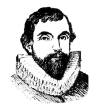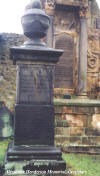|
Rev
Alexander Henderson.

Along with
his friend, a brilliant young advocate named Archibald Johnson of
Warriston (later Lord Warriston ) Alexander Henderson was
responsible for the drafting of both the National Covenant in
1638 and the Solemn League and Covenant in 1643. For these acts
alone he deserves a niche in Covenanting history. But it fell
to Henderson, as Moderator of the General Assembly that met in
November 1638 in St Mungo`s Cathedral in Glasgow, to tell the
Kings representative
“ Sir, if you must leave, we must remain until our duty is done “.
Thus began
the civil disobedience of the Presbyterians against a meddlesome
king.
Born about 1583, In his
early years Henderson had studied at St
Andrews University and in 1611 was chosen to teach philosophy at
the university. in 1612 through the patronage of Archbishop
Gladstanes, he was forced on the unwilling parish of Leuchars
where the people were hostile to him. At that time
he was a prelatist and on his
ordination found that the door of the
church had been nailed closed against
him, and was forced to break in through
a window. However, he happened upon the Rev
Robert Bruce recently returned from exile and was
taken with his preaching. Robert Bruce may have
had some indication that Henderson was in his auditory that day as his
sermon began with
“Verily, verily, I say unto you, he that entereth not
in by the door, but climbeth up some other way, the same is a thief and a
robber.”
The words so matched the ignominious way that Henderson had
taken up his appointment, they clearly had a very great influence upon him
and his eventual adoption of
the Presbyterian way.
Henderson
continued for some time in his quiet
bookish life and grew in character along
with his Presbyterian beliefs, developing not
only as a theologian of considerable merit, but a
powerful and weighty manner of speaking
that simply made people listen to him. Some have
said that he grew in holiness but it was a small man with
great character and presence that was a solitary voice at the
Perth Assembly in 1618 when the obnoxious Articles of Perth
were enacted. In due time he became a counsellor to the Tables (the ruling
body that was formed in 1637) in Edinburgh and would later be co author of the
Covenants, three times Moderator of the General Assembly and a commisioner to the Divines who drew up the Westminster
Confession of Faith. This he was to cram into a span of but
nine years.
Henderson
was held in the highest regard by
his peers. including Rev Samuel Rutherford and Rev
Dickson who regarded him as the foremost and most
statesman- like of the Presbyterian clergy of
the day.
Samuel
Rutherford’s, In a letter of 9 March
1637 wrote:
“As
for
your
case, my reverend and dearest brother, you are the talk of the north and
the south, and so looked to
as if you were all crystal glass; but your motes and your dust will
soon be proclaimed, and trumpets blown at your slips. But I
know you have laid your help upon One who is mighty. Trust
not your comforts to men’s airy and frothy applause, neither lay your
downcastings on the tongues of the mockers and reproachers
of godliness. God has called you to Christ’s side;
and seeing the wind is now in Christ’s face, and you are with
him, you cannot therefore expect the lee side of the ship, or the
sunny side of the brae; but I know you have resolved to take
Christ upon any
terms.”
In 1637
Henderson was compromised into coming into the open about his
support for the Presbyterian way when the Archbishop of St
Andrews instructed him to purchase two copies of the New
Liturgy for the use of his parish. Henderson went to Edinburgh
and stated his objections to the Privy Council and asked that
the Archbishops instruction be cancelled. The Privy Council ,
swayed by his arguements and that of others, sent reports of the
general opposition to the Liturgy to London. Henderson`s skill and
tact in dealing with the matter did not go unnoticed by his peers
as well as his adversaries when events turned to the Covenant.
The
National Covenant is in three parts; the first reciting the older
Covenant, sometimes called the King Confession, of 1581; the second
part listed the various Acts of Parliament which condemned Popery
and confirmed the privileges of the Reformed church; and the
third part was an emphatic protest against the alien methods of
worship which had provoked the troubles of 1638. Archibald
Johnston, Lord Wariston authored the second part and Alexander
Henderson the third part.
So it
was that he was dragged to centre stage and fame by his election
as the Moderator of the General Assembly that met in Glasgow
from 21 November to 20 December 1638. Hendersons moment came
when on 28 November the Kings representative, the Marquis of
Hamilton, protested at the presence of the lay elders ( including
some of the most powerful noblemen such as Rothes, Lothian,.
Cassilis, Eglintoun, Montrose, Wemyss and Home ). Hamilton also
protested at the sentence on the Bishops and denied the Assembly
had authority to act in Episcopalian matters. If they persisted,
he said, he must pronounce the Assembly dissolved and its
enactments invalid. It fell to Henderson to calmly reply
and said the Assembly had no choice but to remain until their
duty was done. The Marquis departed and next day issued a
proclamation ordering all who were not normally resident in
Glasgow to leave the city within twenty four hours.
It was in
Glasgow at this time that Henderson spent time in prayer with
the Marquis of Argyll and to whom credit is given for
conversion of the most powerful man in Scotland. It was Argyll
alone of the nobles present ( he was there as a member of the
Privy Council ) who made his support clear for the General
Assembly and advised them to continue as if nothing had
happened. Henderson warmly welcomed the support of the Marquis and
the General Assembly proceeded to deal severely with the Acts of
previous Assemblies that had ratified Episcopacy; the Service Book,
the Canons, the Court of High Commission and the Articles of
Perth, were all annulled. Eight bishops were excommunicated and
six more deposed or suspended; and, finally, the National Covenant
that Henderson had helped to write, was confirmed.
It was
not without a hint of irony that in 1641 while in Edinburgh
King Charles went to hear Henderson preach and acknowledged the
man`s dignity and honesty by making him a royal chaplain. Thus
Henderson spent some time both holding services for the King
and the royal family in Holyrood Palace and also discussed
church matters with the King.
Henderson
comes to the fore again five years later when the Solemn
League and Covenant was sworn in 1643. In England the
Parliamentary armies were suffering a string of defeats and
desperately needed allies and troops. It was with this military
help in mind that a deputation went to see The Convention of
Estates in Edinburgh and the General Assembly in St Andrews. The
English deputation was successful and needed some form of
written agreement or treaty between them. They were in favour of
a political and civil agreement but the Scots with an interest
in saving souls, and a higher objective of religious conformity
in the three kingdoms, wanted a religious covenant. So it was
that Alexander Henderson drew up the bond between the two
countries – the Solemn League and Covenant of 1643..
In the
summer of 1646, when in the sanctuary of the Scottish Camp at
Newcastle, King Charles requested that Henderson should come and
discuss with him the question of Church government. This
Henderson did, although not a well man he travelled from London
to attend on the King. It was in mid July that Henderson
decided to leave his lodgings in Newcastle and to make for
Leith by ship, wishing to go to his homeland before it was too
late.. He arrived in Edinburgh a man worn out by nine years of
almost unceasing pressure and dedication to the Presbyterian
cause, and worn out in body. He died on 16 August 1646 in his
sixty third year saying “ Never school boy more longed for the
breaking up than I do to have leave of this world “.
He is
buried in Greyfriard Kirkyard beneath a monument inscribed :
Reader
bedew thine eyes
Not for the dust here lyes –
It quicken shall again,
And aye in joy remain
But for thyself, the Church and States
Whose woes this dust prognosticates.

Hendersons
monument bears the marks of later troubles when, shortly after
the Restoration in 1660, the inscription was defaced on the order of the
Kings Commissioner, the Earl of Middleton , and traces of bullet marks can be
seen from shots fired by soldiers sent to deface the monument.
After the `Glorious Revolution` the inscription was restored.
18/07/2011
|